
The Georgian Pin Mill at Bodnant Gardens, brought here from Gloucestershire in 1939
EDWARD I GLOWERS out over the charming old hill town of DENBIGH, from his niche above the huge triangular gatehouse of Denbigh Castle. This was one of the biggest and most powerful of Edward’s castles, begun in 1282 on the site of a previous Welsh fortification. Like Caernarfon and Conwy, the town of Denbigh was turned into a fortified English borough, surrounded by high walls. One of the original gates, Burgess Gate, is still there, as well as long stretches of the wall, which provide an exhilarating walk offering commanding views of the town, with the moors and vales beyond.
Much of the original medieval street pattern survives within the walls, but most of the buildings date from the 16th century, when the town was rebuilt after being burned to the ground during the Wars of the Roses. In the time of Elizabeth I, the Castle and Lordship of Denbigh was held by the Queen’s favourite Robert Dudley, Earl of Leicester, who started to build Leicester’s church by the castle in the hope of attracting the bishopric from St Asaph. This never happened and the church was not finished.
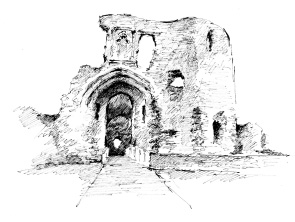
Denbigh possesses a fine collection of chapels, of which CAPEL LON SWAN in Chapel Street, founded in 1742, is the oldest. Also in Chapel Street, CAPEL PENDREF is THE FIRST PURPOSE-BUILT WESLEYAN CHAPEL IN WALES, opened in 1804.
ST MARCELLA S, Denbigh’s parish church, sits 1 mile (1.6 km) outside the town to the east at Llanfarchell, above a holy well where Marchell the Virgin had her hermitage. It’s a grand church from the 15th century, with a double nave and large perpendicular Gothic windows.
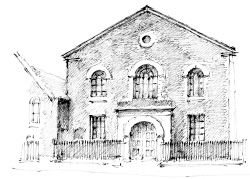
There are a number of fine monuments inside. On the north side, HUMPHREY LLWYD (1527– 68), who was born in Denbigh, kneels beside an angel holding a globe. A scholar, musician and MP for Denbigh, he has been called ‘the Father of Modern Geography’ and produced THE FIRST PRINTED MAP OF WALES, which was published in Antwerp in 1573 and proved so popular that it was reprinted regularly until 1741.
Nearby is a monumental brass of Richard Myddelton and his wife and 16 children. One son, Sir Thomas Myddelton, became head of the Chirk Castle Myddeltons, and another, Sir Hugh Myddelton, developed the ingenious ‘New River’ system that brought water to London from Hertfordshire early in the 17th century.
Remembered in the north aisle, but buried in the churchyard, is Thomas Edwards, or TWM O’R NANT (1739–1810). Known as ‘the Cambrian Shakespeare’, he was the first Welsh playwright of note and was born near Llannefydd, 3 miles (5 km) north-west of Denbigh.
JOHN ROWLANDS WAS born in 1841 in a cottage by the castle gates, the illegitimate son of John Rowlands and Elizabeth Parry (later Jones). He was sent away to the workhouse in St Asaph, from where he ran away to sea at the age of 16. In 1859, he sailed to New Orleans as a cabin boy and was adopted by a merchant called Henry Stanley, whose name he took. As HENRY MORTON STANLEY, he fought for both sides in the American Civil War and then made use of his experiences to become a journalist.
In 1869 Stanley was sent by the New York Herald to look for the Scottish missionary and explorer David Livingstone, who had gone to search for the source of the Nile and hadn’t been heard from since 1866. It took Stanley two years to track his man down, but he eventually found Livingstone in a remote part of what is now Tanzania, near Lake Tanganyika and greeted him, supposedly, with the immortal sound bite ‘Dr Livingstone, I presume?’ It was one of the world’s first great journalistic ‘scoops’ and made Stanley more famous than his subject.
In later years Henry Morton Stanley returned frequently to Africa to explore further. With the support of King Leopold II of Belgium, he opened up the Belgian Congo and prepared the ground for the creation of the Congo Free State.
On returning to Britain he toured the country, lecturing and writing about his experiences, and became MP for Lambeth, in London. He died in 1904 and is buried at Pirbright, in Surrey, under a stone with the simple epitaph ‘Africa’.
RUTHIN IS ONE of the nicest little towns in Wales, an eclectic mix of attractive buildings gathered around a hilltop square, with breezy views of the Vale of Clwyd and the Clwydian Hills.
The handsome wrought-iron gates leading to St Peter’s Church are by Robert Davies of Bersham. Nantclwyd House in Castle Street is a 15th-century timbered cruck house, one of the oldest in Wales, and was once the home of Dr Gabriel Goodman, who became Dean of Westminster for 40 years and founded Ruthin School in 1595. The Myddelton Arms is an unusual Dutch-style building, with a huge sloping roof pierced by seven dormer windows known as the ‘eyes of Ruthin’. Prominent in the square is the Maen Huail, a large stone which local legend says marks where King Arthur beheaded Huail, his rival in love.

The Eyes of Ruthin
Ruthin Castle, once home to the Cornwallis-West family and now an hotel, is a huge castellated mansion of the early 19th century, built on the site of a 13th-century castle of Edward I. Only the battlemented gatehouse remains from the original castle.
Top Formula One racing driver TOM PRYCE (1949–77) was born in Ruthin. On entering Formula One in 1974, Pryce was tipped as a future world champion, before being tragically killed in a freak accident at Kyalami in South Africa, when a 19-year-old marshal ran out on to the track in front of him.
Pop star Elton John’s half-brother GEOFF DWIGHT lives in a small terraced house in Ruthin.
Beatle John Lennon’s first wife CYNTHIA lived in Ruthin during the 1970s and 80s, and ran a bistro called Oliver’s in Well Street. Julian, her son by John, went to Ruthin School. Paul McCartney is thought to have had Julian in mind when he wrote his sad song ‘Hey, Jude’, around the time of Cynthia and John’s break-up.
WIMBLEDON CENTRE COURT, Dan Maskell’s ‘Oh, I say!’, Henman Hill, Maria Sharapova, tennis elbow – we owe them all to the gardens at NANTCLWYD HALL, a 17th-century country house, 3 miles (5 km) south of Ruthin. It was on the lawns here, in 1873, that MAJOR WALTER WINGFIELD sowed the seeds of lawn tennis, after playing a game with a new kind of India rubber ball designed to bounce on grass. It was such fun that he was inspired to write down some rules.
Later that year he published THE FIRST SET OF LAWN TENNIS RULES, and in 1874 he registered a patent for the game, which he called sphairistike. He put together a kit of net, posts, rackets and balls, which he sold along with the book of rules, and the game quickly became hugely popular.
The first Wimbledon tournament took place in 1877, and the Lawn Tennis Association was founded in 1888.
Nantclwyd Hall is a private home, but the exotic 3-acre (1.2 ha) gardens, designed by Sir Clough Williams-Ellis for the Naylor-Leyland family, are sometimes open under the National Gardens Open Day scheme. Amongst the follies, temples and gazebos, dovecote, ceremonial arch and clock tower, as well as formal gardens, it might just be possible to find and walk on THE VERY FIRST LAWN WHERE TENNIS WAS PLAYED.

WREXHAM, RED BRICK and gritty, is the largest town in North Wales and its industrial and commercial capital. A market centre since the 14th century, Wrexham has grown prosperous on leather, iron and coal.
Just a step or two away from the busy, noisy, pedestrianised town centre, a quite beautiful set of wrought-iron gates opens on to another world, the calm, peaceful world of St Giles Church. Wrexham may not be the prettiest town, but it does possess one of the most glorious Gothic towers in the world, the tower of ST GILES, 136 ft (41 m) high, richly carved and pinnacled, one of the Seven Wonders of Wales.
Lying at the foot of the tower, near the west door, in a big stone chest tomb, is ELIHU YALE (1649–1721), benefactor of Yale University in Connecticut, USA. His epitaph begins:
Born in America, in Europe bred
In Africa travell’d, and in Asia wed
Yale was born in Boston, Massachusetts, but was brought to England when he was four. His family’s ancestral home, about 10 miles (16 km) west of Wrexham, was called Plas yn Ial, which was how they got the name Yale, an anglicised version of Ial. Elihu Yale made his fortune with the East India Company and as Governor of Fort George, Madras. In 1718, he helped to raise money for a new building at the Collegiate School of Connecticut, which had been founded in 1701, by donating valuable books and paintings. The building was named after him, and then the university which grew from it.
Yale University in New Haven, Connecticut, is the third oldest institution of higher education in America, and a member of the Ivy League, a group of eight prestigious private universities in the north-east of America that play each other at sports. Wrexham Tower, overlooking Yale University, is a replica of St Giles tower.
As an adult, Elihu Yale lived at Plas Grono, a house near Erddig, just outside Wrexham, that was demolished in 1876. There is a tertiary college named Yale College, after Elihu Yale, in the centre of Wrexham, and in 1999 they were the subject of a lawsuit by Yale University over the use of the name.
In 1881, THE FIRST LAGER BREWERY IN BRITAIN was opened in Wrexham by German immigrants. WREXHAM LAGER was, for a long time, THE ONLY DRAUGHT BEER SERVED ON BRITISH SHIPS, as it was unaffected by the motion of the sea, unlike traditional beer. Because it travelled well, Wrexham Lager was exported all over the world and was even found at General Gordon’s palace in Khartoum, according to a letter posted to the brewery from the Sudan in 1898. Eventually, Wrexham Lager was swallowed up by what became Carlsberg Tetley. In 2000, it was closed down and the factory demolished, except for the historic redbrick, original brewery building which is listed. Wrexham Lager is now brewed in Leeds.
JUDGE GEORGE JEFFREYS (1645–89), the infamous ‘Hanging Judge’ who presided over the ‘Bloody Assizes’ after the Monmouth Rebellion in 1685, was born at Acton Hall on the northern outskirts of Wrexham.
JOHN GODFREY PARRY-THOMAS (1884–1927), who broke the world land speed record at Pendine Sands (see Carmarthenshire), was born in Wrexham.
ANN WILKINSON, wife of John ‘Iron Mad’ Wilkinson, is commemorated inside St Giles church with a classical urn.
IN THE LATTER half of the 18th century, BERSHAM, to the west of Wrexham, was THE FOREMOST IRON-MAKING CENTRE IN THE WORLD. At Croes Foel Farm, just outside the village, a plaque marks the site of the Davies brothers’ smithy, where they produced THE FINEST WROUGHT-IRON GATES IN BRITAIN. Examples of their work in Wales are the churchyard gates of St Giles in Wrexham, forged in 1720 (see above), the White Gates of 1726 at Leeswood Hall near Mold, over 100 ft (30 m) long, and the Great Gates at Chirk Castle, their greatest masterpiece, completed in 1721.
The nearby Bersham Ironworks had been in use since 1640, producing cannons for the Civil War. In 1762, JOHN ‘IRON MAD’ WILKINSON took over the Bersham ironworks from his father, and from 1774 began producing superior cannons of incredible accuracy, using a revolutionary new technique he had patented for boring cannon cylinders from solid cast iron. Bersham cannon were used in the American War of Independence and during the Napoleonic and Peninsular Wars to great effect.

Wilkinson’s cylinders were the only cylinders precise enough to make James Watt’s new steam engines work, and the Boulton and Watt steam engines that powered the Industrial Revolution were built at Bersham.
In 1792, Wilkinson bought the coal-rich Brymbo Hall estate, 3 miles (5 km) to the north, and set up a new ironworks out of which grew the Brymbo Steel Company, which finally closed its doors in 1990.
Bersham Ironworks has been restored and can be visited in the summer months.
Bersham Colliery was first sunk in 1864, and coal was dug here for over 100 years until the mine closed in 1986. The pit-head gear, the last in North Wales, has been preserved and can be seen from the A483 Wrexham bypass.
FOR MOST OF the year LLANGOLLEN is a quiet, respectable Victorian village, clustered around its famous four-arch bridge, one of the Seven Wonders of Wales. But every July the town fills with singers, dancers, musicians and choirs from all over the world, who descend on the Royal International Pavilion for the INTERNATIONAL MUSICAL EISTEDDFOD. The first International Musical Eisteddfod took place in 1947 and was aimed at promoting peace, through music, between the nations after the Second World War. The occasion now attracts participants from over 50 countries.

There has been a bridge at Llangollen since 1284, but the first stone bridge was built in 1345 by the Bishop of Asaph, John Trevor, after whom the present bridge is named. The first bridge was replaced in 1656, and the downstream side of the bridge dates from this time. The upstream side has been altered twice since, in order to widen the bridge, once in 1873 and again in 1968.
The road north from Llangollen, before it starts to snake its way up the dizzying, self-explanatory Horseshoe Pass, goes by the picturesque ruins of VALLE CRUCIS ABBEY, founded in 1201, THE LAST CISTERCIAN ABBEY BUILT IN WALES. The cross referred to in the name is ELISEG’S PILLAR, erected in the 9th century in memory of Eliseg by his great-grandson, Cyngen, Prince of Powys. It stands 8 ft (2.4 m) high, and is beside the road about half a mile (0.8 km) from the abbey.
Buried beneath a three-sided Gothic tombstone in the churchyard of St Collen are the celebrated LADIES OF LLANGOLLEN, Eleanor Butler (1739–1829) and Sarah Ponsonby (1755–1831), along with their maid Mary Caryll. The two ladies eloped from their homes in Ireland, after many adventures, and set up home at PLAS NEWYDD, a modest cottage on a hill overlooking the village. They were on their way to England, along the A5 from Holyhead, but fell in love with Wales, which they thought the most beautiful country in the world, and decided to stay.

They were an odd couple, and would walk around Llangollen dressed in dark riding gear so that they looked more like men, and they spent their time gardening, painting and reading. They grew their own fruit and vegetables, kept cows as well as dogs and cats, and loved collecting things, especially anything carved in oak. The house is still bulging with all their treasures.
The Ladies of Llangollen became one of the sights of the village, and before long it was de rigueur for any prominent figure travelling between London and Holyhead to stop off and see them. A small gift of a wooden carving was always welcome. Sarah Siddons, Edmund Burke, Sir Walter Scott, the Duke of Wellington and William Wordsworth – all dropped by and were entertained, for the Ladies could talk to anyone on any subject.
After the Ladies had died, Plas Newydd passed through several hands before being taken on by a retired general who converted the house and collection into a museum, formalised the garden and had the Elizabethan timbering we see today added to the cottage. The house and gardens are now owned by Denbighshire County Council, and are open to the public during the summer months.
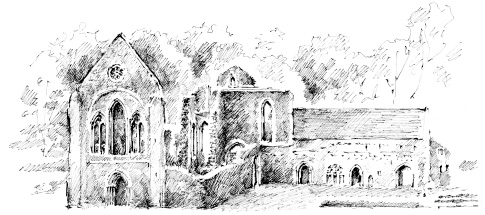
Valle Crucis Abbey
TAKE A BOAT east along the Llangollen Canal from Llangollen, and you will soon find yourself floating 126 ft (38 m) above the River Dee, on THE WORLD’S HIGHEST BOAT RIDE ABOVE LAND, courtesy of Thomas Telford’s supreme PONTCYSYLLTE AQUEDUCT, at 1,007 ft (307 m), THE LONGEST AQUEDUCT IN BRITAIN. Completed in 1805, it was THE FIRST AQUEDUCT IN THE WORLD TO USE A CAST-IRON TROUGH, SET ON HIGH PILLARS, of which there are 18. Even by Telford’s standards Pontcysyllte was an astoundingly bold and brilliant piece of engineering. Sir Walter Scott called it the finest work of art he had ever seen.
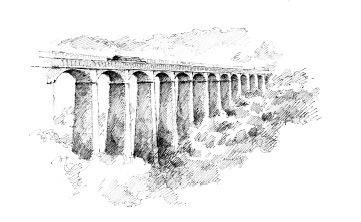
It is a toe-tingling experience to walk along the towpath over the aqueduct, beside THE LONGEST IRON TROUGH IN BRITAIN, as gaily painted narrow boats glide by, separated from the awful drop by no more than a few inches of fragile cast-iron lip. If you can bring yourself to look, the prospect of the Dee valley from the centre of the aqueduct is tremendous, and includes a distant view of Telford’s earlier Chirk Aqueduct, running alongside Henry Robertson’s huge railway viaduct of 1848.

RIGHT ON THE border with Caernarfonshire, Rhos-on-Sea sits on a promontory between the sands of Colwyn Bay and Penrhyn Bay. At the western end of the Promenade, almost on the beach, is the tiny, stone, buttressed ST TRILLO’S CHAPEL, THE SMALLEST CHAPEL IN BRITAIN, measuring only 11 ft (3.4 m) by 8 ft (2.4 m). The original structure, built next to a drinking well, was 6th-century, and was related to a nearby monastery founded by St Trillo, a monk from Brittany. The chapel seats six people and is used each Wednesday for an Anglican Communion service. Out on the sands, low tide reveals the remains of a small, stone-walled enclosure built by the monks to trap fish, which would be stranded within when the water receded.
A brass plaque in a garden near the chapel commemorates the historic voyage of PRINCE MADOC, who is said to have sailed from here in 1170 to discover America, 300 years before Christopher Columbus. Prince Madoc, born at Dolwyddelan Castle, was an illegitimate son of King Owain Gwynedd. In 1170, to escape the fighting after his father’s death, he sailed west from Rhos-on-Sea with two ships, to try and find the promised land beyond the western horizon. Madoc returned with tales of a wonderful new country across the sea and persuaded others of his countrymen to accompany him back there and start a new life. In 1171 Madoc and his companions sailed towards the setting sun and were never heard of again.
Many people believe that Prince Madoc did survive, landing at Mobile Bay in Alabama, and travelling inland up the Alabama River. Explorers who followed after Columbus discovered a series of forts along the Alabama River, apparently dating from well before Columbus’s arrival, and closely resembling the hill forts of Wales. One of the forts, on Lookout Mountain, near DeSoto Falls, Alabama, showed striking similarities, both in its setting and in its design, to Madoc’s birthplace, Dolwyddelan Castle.
Later explorers came across a tribe of blue-eyed Red Indians with fair skin and brown hair, living on the banks of the Missouri River, who called themselves Mandans. They spoke, in a language very like Welsh, of their tribe coming originally from the Gulf of Mexico, and they fished in round boats like Welsh coracles. And their settlements were built on rocky outcrops, as in Wales. Were they the descendants of Madoc and his companions, and did the Welsh discover America?
Buried in the church at Llandrillo-yn-Rhos is HOWARD LOWE (1882–1944), Fifth Officer on the Titanic, and one of the few men to row back to the sinking ship to look for survivors. He was played in the Oscar-winning film Titanic by Welsh actor Ioan Gruffydd.
Pistyll Rhaeadr and Wrexham steeple,
Snowdon’s mountain without its people,
Overton yew trees, St Winefride’s Well,
Llangollen Bridge and Gresford bells
Denbighshire Possesses Four of the ‘Seven Wonders of Wales’. These ‘wonders’ feature in the above poem, written anonymously in the late 18th century, and have sparked lively debate ever since – especially as they are all in North Wales!
The bells in the lovely 15th-century pinnacled bell tower of ALL SAINTS CHURCH in GRESFORD, one of the finest churches in Wales, are amongst the Seven Wonders of Wales. A new set of lighter bells was added in 2006.
GRESFORD, once a mining town, is known for its disasters as well as its wonders. In 1934, a series of explosions inside the Gresford coal-mine killed 262 miners, three rescuers and a surface worker, in one of the worst mining disasters in British history.

Denbigh was one of the few places in Wales that the old curmudgeon DR JOHNSON approved of. For a short while he was a guest of the Myddeltons of GWAENYNOG HALL, just outside the town, and in the grounds you can still see the riverside cottage where he stayed, as well as Johnson’s Monument, erected by Colonel Myddelton to commemorate the good doctor’s visit.
The gardens of GWAENYNOG HALL are the setting for Beatrix Potter’s Tale of the Flopsy Bunnies. The hall belonged to her mother’s family, and while staying here, Beatrix drew inspiration for her illustrations from the wonderful Victorian gardens. Mr McGregor’s potting-shed is still there, as are plenty of flopsy bunnies, and the present owner, Janie Smith, Beatrix Potter’s great-great-niece, has restored the gardens to how they would have looked when Beatrix was here in the 1890s.
In the grounds of TY’N DWR HALL, near Llangollen, which is now a Youth Hostel, is THE LARGEST YEW TREE IN WALES.
The entrance to the spreading grounds of CHIRK CASTLE (NT), in the Marcher lands south of Wrexham, is through the most breathtakingly beautiful set of wrought-iron gates in Britain, the finest masterpiece of the Davies brothers of Bersham. The castle, on top of a small hill, is low and brooding with huge round drum towers at each corner. It was begun by Edward I’s mightiest Marcher lord, Roger de Mortimer, in the 13th century, and oozes power and intimidation. You approach, with some trepidation, the soaring entrance arch, emblazoned with a coat of arms in stone and barred by vast, iron-studded wooden doors. The awe is palpable. The hand trembles. And there, beside the door, is a tiny bronze doorbell saying ‘Myddelton’. Just so the postman knows.
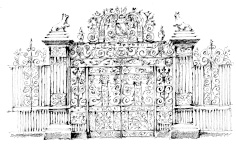
The underground workings of Bersham Colliery reached beneath the wonderful, late 17th-century ERDDIG HALL, and although a large pillar of solid coal was left in place directly under the house, Erddig was nevertheless seriously damaged by subsidence. The last owner, Philip Yorke, handed Erddig over to the National Trust in 1973, complete with contents. Erddig is the only stately home where the world of the servants takes pride of place. The Yorkes, who lived there from the early 18th century, commissioned portraits of all their servants and kept notes of their daily lives together, creating a unique record of servant life in a country house over two and a half centuries.
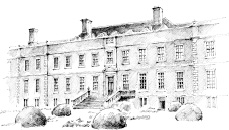
LLANFAIR TALHAEARN, a pretty village beside the River Elwy, west of Denbigh, was the birthplace of the poet and architect JOHN JONES (1810–89). Jones worked under Sir Joseph Paxton and oversaw the construction of the Crystal Palace for the Great Exhibition of 1851. Regarded as one of the best builders and architects of his day, he had to retire far too young owing to crippling arthritis, and spent the rest of his life trying, unsuccessfully, to win the Chair at the National Eisteddfod. He is buried under a yew tree in the steeply rising churchyard.
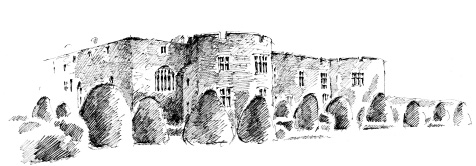
The small town of LLANRWST, north of Betws-y-Coed, is the market centre for the Conwy Valley and is known for its steep and narrow bridge, thought to be the work of Inigo Jones – certainly there is a Stuart coat of arms dated 1636 on the parapet. In the Gwydir Chapel of the church of St Gwrst is a tomb, said to be that of LLYWELYN THE GREAT, first moved from his abbey at Aberconwy to Maenan Abbey in 1283, and then to Llanrwst at the Dissolution.

PISTYLL RHAEADR, one of the Seven Wonders of Wales, is THE TALLEST WATERFALL IN ENGLAND AND WALES. Tumbling down off the moorland of Berwyn, the Afon Disgynfa falls 240 ft (73 m), after which it becomes the Afon Rhaeadr. As George Borrow, the 19th-century author of Wild Wales put it, ‘I never saw water falling so gracefully …’ Pistyll Rhaeadr is located at the head of the valley some 3 miles (5 km) north-west of the village of Llanrhaeadr-ym-Mochnant, where William Morgan was Rector and worked on his translation of the Bible into Welsh.
Buried in the church at LLANNEFYDD, high up on the moors north-west of Denbigh, is CATRIN O FERAIN (1534–91), known as ‘Mam Cymru’ or ‘Mother of Wales’. She was a direct descendant of Henry IV and one-time owner of Penymyndd, the ancestral home of the Tudors on Anglesey. Four times she married, each time to a rich and influential man. Her second husband was Elizabeth I’s factor in Antwerp, merchant banker and architect Richard Clough, who founded the London Stock Exchange and was an ancestor of Portmeirion architect Sir Clough Williams-Ellis. Amongst her descendants were the Williams Wynns of Wynnstay, near Ruabon, at one time the richest and most powerful landowning family in North Wales. It is said that she disposed of her many lovers by pouring molten lead in their ears, and burying them in the garden.
Monty Python star TERRY JONES was born in COLWYN BAY in 1942.
James Bond actor TIMOTHY DALTON was born in COLWYN BAY in 1946.
TV personality PAULA YATES (1960–2000) was born in COLWYN BAY. Presenter of The Tube and Big Breakfast, she married Live Aid star Bob Geldof, with whom she had three children, Fifi Trixibell, Peaches and Pixie. She later had a daughter by INXS singer Michael Hutchence, Heavenly Hiraani Tiger Lily. Late in life she discovered that her real father was not the Stars on Sunday TV presenter Jess Yates, as she had been told, but another TV presenter, Hughie Greene of Opportunity Knocks.
ST MICHAEL’S CHURCH, ABERGELE, is THE LARGEST CHURCH WITH A DOUBLE NAVE IN WALES.

In the churchyard of St Michael’s Church, Abergele, there is a memorial to the 33 people who died in a terrible train crash at Llanddulas, a little west of Abergele. The Irish Mail express from Chester ran into some runaway wagons, loaded with paraffin, that had rolled down the hill from quarry sidings. The passengers were locked into their compartments for safety, and when the gas lighting in the train ignited, 33 of them were burned alive. In 1969, two Welsh separatists, Arwel Jones and George Taylor, were killed while trying to place a bomb on the railway line at Abergele, to sabotage the train bringing Prince Charles to Caernarfon Castle for his Investiture.
CAPTAIN MATTHEW WEBB trained in the sea off PENSARN before becoming THE FIRST MAN TO SWIM THE ENGLISH CHANNEL in 1875.